I can’t tell you the joy felt from the butterflies we’ve had in our garden this past season. The large bed at the end of the patios is an unorganized cluster of blooms that has been the feeding ground for a kaleidoscope of guests. No one knows for certain why we call them butterflies. The word can be traced back as far as the earliest parts of the eighth century. One notion is that butterflies would fly into kitchen to feed on uncovered milk and butter. The German word for butterfly is milchdieb, which when translated means milk thief. Legends and Myths suggest fairies stole butter in the form of these creatures at night. Other theories suggest it is because yellow is a primary color for them. My father has called them Flutter-bys for as many years as I can remember, and truthfully, what describes them better?
There are over 250 varieties of North American Skippers and over 3000 world wide. This is a picture of a male Fiery Skipper. He’s a wonderful orange color with brown spots. The female has the exact opposite colors, brown with orange spots. They are sometimes called Grass Skippers because as caterpillars they feed on St. Augustine and Bermuda grass. I’ve read that the caterpillars are pinkish green in color and have black heads. I’ve also read that they are hard to see because they protect themselves from predators by staying close to the grass roots. The adult butterflies keep their wings in a type of jet plane position until they warm up, and then they sometimes close them. If you have ever tried to take a picture of one you’ll see they move just about that fast as well.
The Dun Skipper is dark brown in color. The male has a dark colored stripe on each forewing called a stigma. A stigma is a dark or black colored streak of scales on the front wing that produces pheromones to attract females. The females are the same color except they have small light colored spots in the center of their forewings. Like the Fiery Skippers, they prefer sedges in the caterpillar stage of their lives. As adult butterflies they prefer moist areas near swamps, streams or meadows and choose white, pink or purple flowers over all others.
This little fellow is a male Common Checkered Skipper. The only distinguishable difference that I know between the male and the female is the color. The male has a bluish silver body with hair spreading to the wings and the female has a dark grey body that has little or no hair. The host plants for these butterflies before they earn their wings are Mallow plants. They prefer Apricot Globe Mallow and Hollyhocks. As adults they like the nectar of all flowers but prefer Asters above all others.
This Variegated Fritillary is a butterfly I don’t see that much of in our area. The host plant for this autumn colored beauty is varied. Some of the plants they will use as a host plants are May Pops, Violets, Sedum and Portulaca. As adult butterflies they tend to be partial to the nectar of Butterfly Weed, Common Milkweed and Red Clover. They can overwinter in the deepest parts of the South and in other areas they may migrate.
The yard is awash with Gulf Fritillary butterflies right now and I can’t resist the urge to post several pictures of them. I’ve always loved their bright orange color and when I see those perfectly colored silver spots on the underside of the wings I am simply amazed. How do they make that color? If you want these guys in your garden you should plant Passion Vines and lots of Lantana. Passion Vines are their host plants of choice, butthey find the nectar of Lantana delicious.
My favorite butterflies are the tattered ones. I know they have lived long fulfilled lives...
Painted Ladies are another type of butterfly we rarely see in our garden. Once we get our Hollyhocks growing and plant a few more varieties of sunflower perhaps we can entice them to visit us more often. Who knew that a butterfly could have such finicky tastes when it comes to flower nectar. The one is this picture has tattered little wings. How many more trips to Mexico can it make for the winter?
The Eastern Tiger Swallowtail has always been my very favorite butterfly. The one in this picture is a female. You can tell the difference by the blue on the back wings. A male has very little or no blue on its wings, most of the time just a spot on each one. The can be either yellow with black stripes or just black. In the past I’ve mistakenly posted a Black Tiger Swallowtail as a Pipe Vine Swallowtail. That picture is listed below and you can better see the blue that indicates a female in the striped variety. One really interesting thing I learned is that sometimes these butterflies can suffer from gender confusion and be both male and female. When this happens they can have yellow wings with black stripes on one side and have black wings on the other. Or, the can also become some of the most amazing patterns and colors described as Mosaic. When this happens, the butterflies are called Gynandromorphs. Tiger Swallowtail butterflies tend to use trees as host plants, Tulip Poplar, Wild Black Cherry and Sweet Bay Magnolias to name a few.
This is a black female...
A few years back, the weather was starting to cool off at night and it was time to move in the house plants. One particular night the temperature dropped really low extremely fast and it was late in the evening when I drug the plants in for the night. The next morning I woke up, walked into the kitchen and the room was absolutely filled with fluttering Sulfur butterflies. They were everywhere, what a wonderful thing to wake up to in the morning. It’s not every day that you arrise from slumber to a house filled with butterflies. Evidently they had settled in the plants for the night and had become immobile from the cold. When the heat from the house warmed them up they were ready to fly again. Cloudless Sulfur butterflies will be in your garden no matter what flowers you have planted. But where ever you find Wild Morning Glories you are sure to find these yellow gems.
No butterfly post would be complete without a photo of a Monarch. The one pictured below is a male drying his wings. They are easily identified by the black dots on the rear wings. These are the glands that produce the pheromones to attract the ladies. We make certain to keep plenty of Scarlett Milkweed planted in our garden to keep these guys laying eggs and to provide the caterpillars something to munch on while they grow. After the show of Monarchs we had a couple of weeks ago, you can rest assured we will find a place for more milkweed in the spring.
It would be impossible for us to plant all the host plants we would like to have; we simply don’t have the room. We will certainly do what we can to keep attracting butterflies to our garden. Nothing has given me greater pleasure than these wonderful little creatures have this past summer. It already gives me something to look forward to next season.

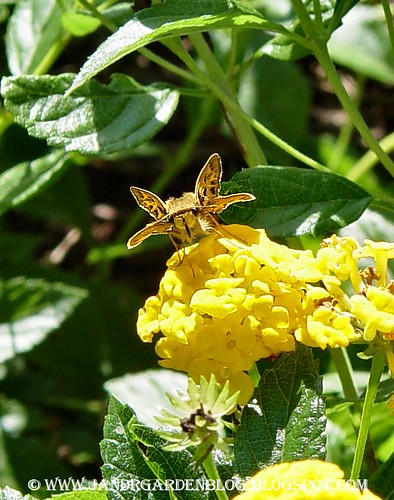



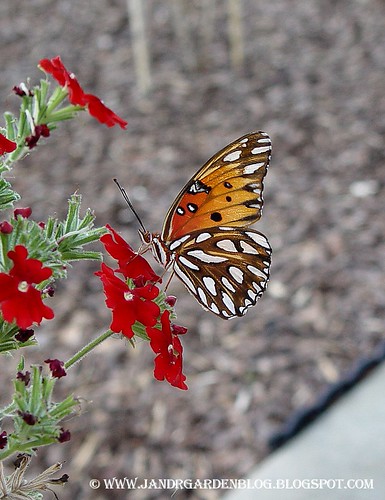
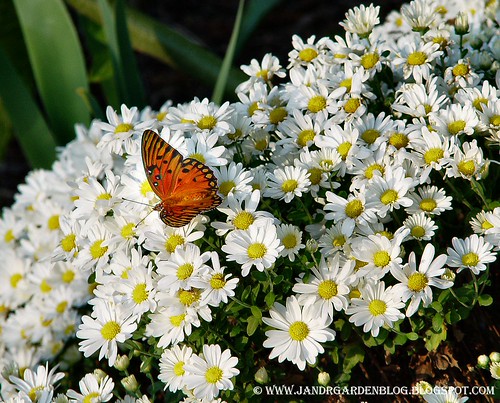

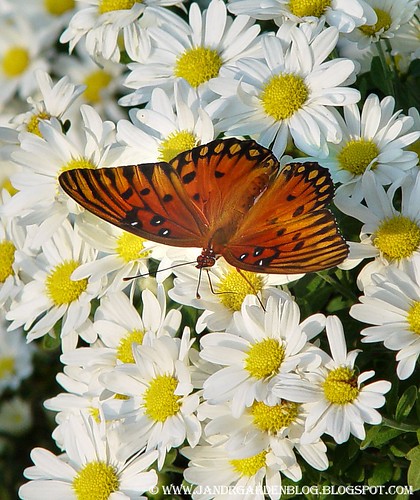

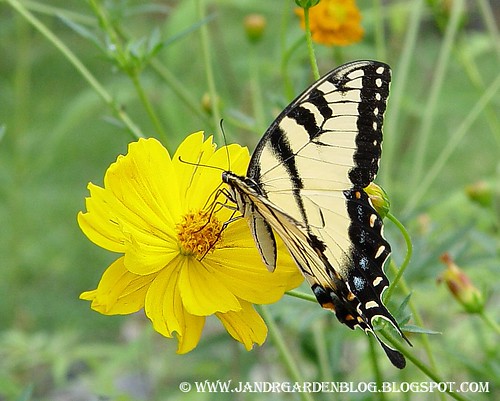
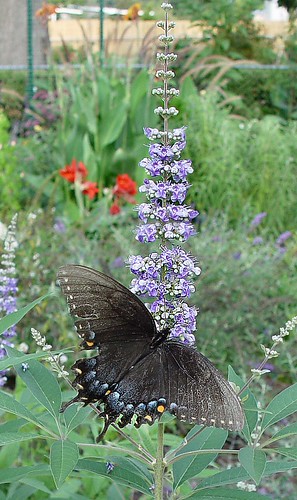



12 comments:
What a marvelous experience with the sulphurs. Did you manage to get them all outside? Great pics too.
I loved the butterflies and I am glad to finally know the name of the skipper I see almost everyday! I do like the sulphur story, too! Gail
You really were able to capture some great photos of the little flying, garden visitors you have. Gulf Fritillary butterflies are my absolute favorite. They seem like such happy creatures.
Jan
Always Growing
Pam, I didn't want to let them out, but I did. I would have been perfectly content to let them fly around in there forever. :-)
Gail, I had to have help from another gardening friend that is a bug genius. She knew instantly what type of skipper it was. I don’t know how she does it, but I have never had a single plant or insect she can’t eventually identify for me.
Jan, it’s not easy to get good photos of such impatient little things. I average about one good photo in every six I take. Aren’t the Gulfs and Mums gorgeous?
I really enjoyed that post. The Variegated Fritillary is beautiful. I've never seen one before.
Butterflies all gone here. In fact its beginning to snow.
Marnie
This is such a beautiful post, Randy & Jamie - at least on your page the butterflies stay still long enough so we can try to match names with wings!
The idea of waking up to a cloud of sulphur butterflies in your house is enchanting.
Annie at the Transplantable Rose
Marnie,
I don't see alot of the variegated ones. The really like hot dry areas. It is a beautiful thing. We just had our first frost this morning and it was totally unexpected by me. I didn't think we would get one for another month or so. I don't remember frost this early.
Annie,
I'm glad you enjoyed the post. There are several other kinds of skippers in out garden, but they won't sit still long enough for me to get their picture. LOL
Thanks for telling us the history behind the butterfly name, it makes perfect sense. I especially like the thought of fairies transforming into butterflies to steal butter! What a captivating thought. Your shot of the gulf fritt on the red verbena is a masterpiece!
Frances
http://fairegarden.wordpress.com/
Frances,
Thank you this was a very easy post for me to do because I love butterflies so much. Next year I hope we have tons of new butterflies. Several people have commented that the gulf on the red verbena is their favorite. I don’t think I could pick a favorite, but I do particularly like the Gulf and Mums pictures.
So glad you included the skipper in your post, I had one in my garden this year but had no idea what it was called. Thank You, Machelle
Machelle, I'm glad you learned something from this. It excites me when something good comes out of one the post! - Randy
Those are some great pics!
Post a Comment